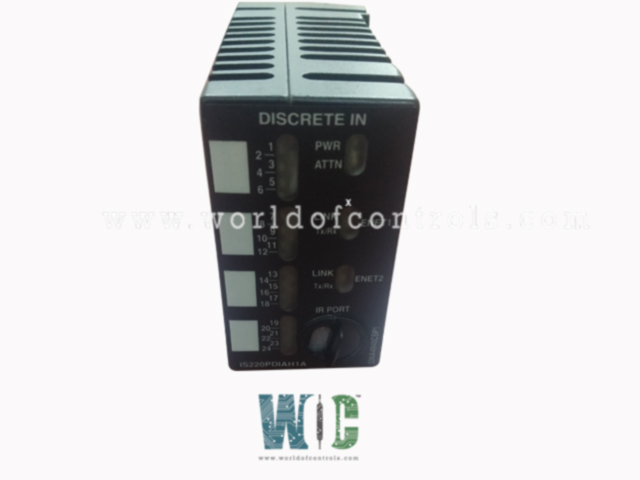
World Of Controls understands the criticality of your requirement and works towards reducing the lead time as much as possible.
IS220PDIAH1A - Discrete Contact Input Terminal Board is available in stock which ships the same day.
IS220PDIAH1A - Discrete Contact Input Terminal Board comes in UNUSED as well as REBUILT condition.
To avail our best deals for IS220PDIAH1A - Discrete Contact Input Terminal Board, contact us and we will get back to you within 24 hours.
SPECIFICATIONS:
Part Number: IS220PDIAH1A
Manufacturer: General Electric
Product Type: Discrete Contact Input Terminal Board
Function: I/O Module
Series: Mark VIe
Number of channels: 24
Operating temperature: -40 to +70°C
Size: 15.9 cm high x 17.8 cm
Input isolation in pack: Optical isolation to 1500 V on all inputs
Input Filter: Hardware Filter, 4 ms
AC Voltage Rejection: 60 V rms at 50/60 Hz at 125 V dc excitation
Availability: In Stock
Weight: 0.8kg
Repair: 3-7 Day
Country of Origin: USA
Manual: GEH-6721D
FUNCTIONAL DESCRIPTION:
IS220PDIAH1A is a Discrete Contact Input Terminal Board manufactured and designed by General Electric as part of the Mark VIe Series used in GE Distributed Turbine Control Systems. The PDIA I/O pack provides the electrical interface between one or two I/O Ethernet networks and a discrete input terminal board. The pack contains a processor board common to all Mark VIe distributed I/O packs and an acquisition board specific to the discrete input function. The pack accepts up to 24 contact inputs and terminal board-specific feedback signals, and PDIA accepts three different voltage levels (with types TBCIH1, H2, and H3 terminal boards). Connections for the isolated discrete input board with voltage sensing (with type TICI board) are available. System input to the pack is through dual RJ45 Ethernet connectors and a three-pin power input. Discrete signal input is through a DC-37 pin connector that connects directly with the associated terminal board connector. Visual diagnostics are provided through indicator LEDs, and local diagnostic serial communications are possible through an infrared port.
COMPATIBILITY:
PDIAH1A is compatible with five types of discrete contact input terminal boards, including the TBCI boards, TICI boards, and STCI boards, but not the DIN-rail mounted DTCI board. Control mode refers to the number of I/O packs used in a signal path:
INSTALLATION:
OPERATIONS:
The processor board connects to an acquisition board specific to the I/O pack function. Upon application of input power, the soft-start circuit ramps up the voltage on the processor board. The local power supplies are sequenced on, and the processor reset is removed. The processor completes self-test routines and then loads application code specific to the I/O pack type from flash memory. The application code reads board ID information to ensure the correct matching of the application code, acquisition board, and terminal board. With a good match, the processor attempts to establish Ethernet communications, starting with the request of a network address. The address request uses the industry standard dynamic host configuration protocol (DHCP) and the unique identification read from the terminal board. After Ethernet initialization, the processor programs the onboard logic, run the application, and enables the acquisition board to begin operation.
WOC has the largest stock of GE Distributed Control System Replacement Parts. We can also repair your faulty boards. WORLD OF CONTROLS can also supply unused and rebuilt backed-up with a warranty. Our team of experts is available round the clock to support your OEM needs. Our team of experts at WOC is happy to assist you with any of your automation requirements. For pricing and availability on any parts and repairs, kindly get in touch with our team by phone or email.
What are the voltage and current specifications of the board?
The voltage and current specifications can vary based on the specific model of the board. Refer to the board's documentation for detailed technical specifications.
How many devices can I connect to the board?
The number of devices that can be connected depends on the number of input terminals available on the board. This number varies across different models.
How do I integrate the board with my control system?
The board usually interfaces with a control system (like a PLC or microcontroller) through standard communication protocols or signal interfaces. Consult the board's documentation for integration details.